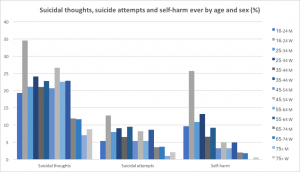Learning Analytics as a tool for supporting student wellbeing – Learning Analytics and Student Mental Health & Wellbeing
By Samantha Ahern, on 20 November 2017
Learning analytics is defined as ‘the measurement, collection, analysis and reporting of data about learners and their contexts, for purposes of understanding and optimising learning and the environments in which it occurs’(“Guest Editorial – Learning and Knowledge Analytics. Educational Technology & Society, 15 (3), 1–2. Siemens, G., & Gašević, D. (2012)”, n.d.).
Applications of learning analytics include Early Alert and Student Success, Course Recommendation, Adaptive Learning and Curriculum Design(Sclater, 2017).
Can and should this learning analytics be extended to identify normative behaviours of students and recognise changes to those behaviours, aiding pastoral support?
Although much of the data for informing pastoral support is the same as that for Early Alert and Student Success the aims and implications are different. The data needs may also be more demanding. For example, there will be additional considerations around data sharing and protection as mental ill-health is classified as a protected characteristic.
For inclusion of engagement data from virtual learning environments, this would involve understanding the seasonality of student interactions with online course content, cohort interactions, how a student’s interactions are differing from both their cohort and their own normative behaviour with respect to the seasonality.
Prinsloo and Slade (Prinsloo and Slade, 2017) note that ‘Not only do various stakeholders in the institution work in silos, responding independently of each other and resulting in overlap and inconsistencies, institutional sense-making of students at risk is also fragmented’, which may hinder student well-being support.
Evidence on the effectiveness of learning analytics based interventions in unclear. A systematic review and quality assessment of studies on learning analytics in higher education by the University of Exeter(Sonderlund and Smith, 2017) was only able to include 20 of 560 papers identified due to the methods employed in the studies, only 4 studies evaluated the effectiveness of interventions based on learning analytics. The key recommendation from the review is that more research into the implementation and evaluation of scientifically-driven learning analytics to build a solid evidence base.
The combination of the lack of evidence of the effectiveness of learning analytics based interventions and the potential negative consequences for both our students and institutions, therefore causes us to question whether learning analytics should be used to support student mental well-being.
Conclusion
Student mental wellbeing and in particular student mental ill-health is of major concern, with 48% of UK HEIs having appropriate policies in place(Universities, 2015), and continually needs to be addressed.
An “unhelpful divide” of distinguishing intellectual needs from emotional needs, then students mental health may suffer if the emotional needs are ignored(“What Happened to Pastoral Care? | HuffPost UK”, n.d.). Therefore, pastoral care in addition to academic support is crucial student mental wellbeing.
The Higher Education Academy UK Professional Standards Framework (“UK Professional Standards Framework (UKPSF) | Higher Education Academy”, n.d.) dimension A4, Developing effective learning environments and approaches to student guidance, indicates that student support is an area of activity in which those teaching and supporting learning in higher education should be involved. Additionally, the Universities UK #stepchange(“#stepchange”, n.d.) guidance states that HEIs should seek to promote a diverse, inclusive and compassionate culture as part of their preventive actions.
Unfortunately, there are a number of inadequacies with the current provision of pastoral care in UK Higher Education Institutions. I propose that learning analytics can be used to help to address some of these inadequacies by providing timely and meaningful data to personal tutors about their tutees., this is in alignment with the Univerisites UK guidance(“#stepchange”, n.d.) to align learning analytics with student wellbeing. However, this will require action on behalf of tutors, and there are legal questions still to be answered around negligence and failing to act on or engage with information provided via learning analytics.
Despite the potential ethical and legal issues around using learning analytics to support pastoral care and student mental wellbeing, I believe that this application area that should be explored.
References:
 Loading...
Loading...
 Close
Close



